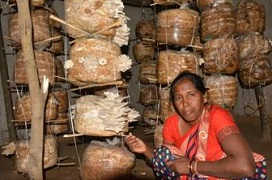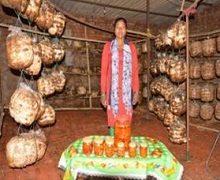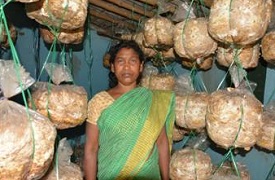In Jharkhand, naturally grown Mushrooms are also consumed widely by the local people. However, due to the short period of availability of naturally growing mushrooms, their commercial cultivation has lots of potential in the state. More than 84% of the farmers in the state are small & marginal farmers and Oyster Mushroom Cultivation could help to ensure additional income by the utilization of available resources like paddy straw.
Keeping this in mind, the Farming System Research Centre for Hill and Plateau Region, Ranchi (FSRCHPR) of ICAR-RCER carried out the technology demonstration on Oyster Mushroom Cultivation under the DBT Biotech KISAN Hub Project in three Villages - Sarwal, Hahap and Koiribera located at 18 to 23 Kms from Ranchi, Jharkhand.
At the beginning of the project during 2019, the average agricultural income of the farmers in the Project Villages was Rs. 1.7 Lakh per Year. The assessment of availability of paddy straw indicated that nearly 38% of the total paddy straw produced in the farming systems remains unutilized. The prevailing food consumption pattern of the farm families indicated cereal dominated diet with acute deficiency of pulses, vegetables, oil seeds and animal proteins.
After undergoing the training on Oyster Mushroom Cultivation at the ICAR-RCER, FSRCHPR, Ranchi, Jharkhand, a total of 57 farmers from Sarwal Village started the Oyster Mushroom Cultivation during 2019. During this period, the biological efficiency ranged between 76.4% to 85.3% with a total production of 3081 Kg of Oyster Mushroom. The farmers could generate a total income of Rs. 3,96,720/- with an average Benefit: Cost Ratio of 3.8 by selling their produce in the local market for Rs. 120 to Rs. 150 per Kg.


Encouraged by the success of Oyster Mushroom Cultivation with the limited number of farmers during the first year, a total of 88 farmers, mostly from Sarwal Village started growing the Oyster Mushroom. During the year 2020 -21, the total Mushroom production from the adopted villages was nearly 7.7 Tonnes. The Mushroom growers of Sarwal Village have constituted a farmers’ group - “Sarwal Ajeevika Mahila Mushroom Utpadak Sangh” for the cluster-based production of Oyster Mushrooms.

Many members of the group have also started the value-addition to the fresh Mushroom produced by them. The different processed products like Dried Mushroom, Mushroom Powder and Pickles are being prepared by them. A sizable amount of the processed products are being marketed in the local market, while a part of the dehydrated products are being consumed in the farm families.
Smt. Basanti Devi of Sarwal Village used to earn her livelihood by working as daily wage laborer in the nearby Villages besides, earning from her own small shop. Her gross annual income from all the activities was approximately Rs. 24,750/-. After getting trained, she had started growing the Oyster Mushroom in a vacant room in her home with the help of her daughter. With continuous hand holding by the Institute, she had already produced more than 400 Kg of Oyster Mushroom out of which 360 Kg have been sold in the local market with total additional income of Rs. 43,200/-.
Having a total area of 5 acres, Smt. Jharia Lakra of Sarwal Village utilized only 1.1 acres mainly for growing paddy and other Rainfed crops. With a significant part of her income from Goatary, her total agricultural income was nearly Rs. 49,500/- per annum. After getting trained in Mushroom Cultivation, she is growing the Mushroom in two rooms with a total area of nearly 150 sq m. During 2020-21, she had produced more than 700 Kg of Mushroom and sold them in the local market @ Rs. 120 to Rs. 140/- per Kg with a total earning of Rs. 94,500/- approximately. She has also adopted the technology of Vermicomposting of Spent Mushroom Media in HDPE bags and is using the vermicompost in the vegetable crops.
With the introduction of Oyster Mushroom Cultivation in the farming system, the farm families were able to earn an additional income between Rs. 1,200 to Rs. 33,075. Now, the consumption of Oyster Mushrooms has increased from less than 2.0 Kg per Year to more than 40 Kg per Year due to the easy availability of Mushrooms at home. Apart from the mushroom, nearly 2 tonnes of Vermicompost could also be produced by the Mushroom growers by the recycling of spent substrate of Mushroom using the HDPE vermibed demonstrated under the project.
(Source: ICAR-Research Complex for Eastern Region, Farming System Research Centre for Hill and Plateau Region, Ranchi, Jharkhand)







फेसबुक पर लाइक करें
यूट्यूब पर सदस्यता लें
X पर फॉलो करना X
इंस्टाग्राम पर लाइक करें